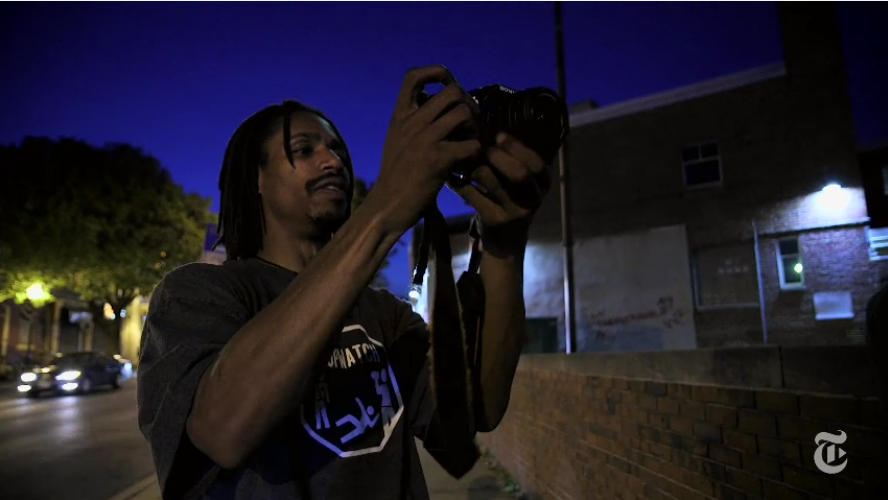Published August, 2015 by Jackie Zammuto in Uncategorized
Filming Police Abuse: A Roundup of Resources and Guidance
Originally published August 2015, Last Updated July 2021
By Jackie Zammuto
As WITNESS continues to explore the impact of eyewitness videos of police abuse in the United States, we are also examining what bystanders need to know in order to document police encounters safely and effectively. Some of the most common questions we hear are:
- What are my rights to film a police encounter?
- What information should I record, and how?
- I’ve just filmed police abuse. What should I do with the video? What are the most effective ways to share it and with who?
- I’ve been collecting videos of police abuse during protests. How do I preserve, organize and curate them to support legal and advocacy initiatives?
While there is no right or wrong answer to most of these questions, the decisions an eyewitness makes before, during and after filming can determine how effective their footage can be in achieving accountability for injustice.
To address these questions, we’ve compiled a list of resources from groups like American Civil Liberties Union (ACLU), Electronic Frontier Foundation (EFF), CopWatch, Justice Committee, and WITNESS, that provide guidance for those who film police encounters in the U.S. They are divided into the following categories: Know Your Rights, Filming Techniques, Livestreaming, Distribution & Reporting, and Preservation. Below are a few recommendations from each category.
Know Your Rights
- WITNESS
- Want to Record the Cops? Know Your Rights
- How Could States Wiretapping Laws Affect Your Right to Film Law Enforcement?
- Getting Started with Digital Security 101: Learn how to assess risks and find tools for how to mitigate them.
- ACLU – Know Your Rights – Filming and Photographing the Police: Good overview of your rights to photograph and film the police.
- Communities United for Police Reform (CPR) – Know Your Rights! Help End Discriminatory, Abusive and Illegal Policing (NYC): A nicely designed pamphlet on how to interact and respond to police in a variety of scenarios, including cop watching, stop-and-frisk, being pulled over in a car, etc. Focused on New York State, also available in Spanish.
- EFF – Know Your Rights – Phone and computer seizure: Focuses on the Fourth Amendment protection against unreasonable government searches or seizures of your computer or portable electronic devices, such as cell phones or cameras.
Filming Techniques
- WITNESS
- Filming the Police in the USA and a video series on Filming Protests & Police Misconduct: Quick tips for safely and effectively filming protests and misconduct (also available for download here).
- Use This App to Film the Police…or Not: Guidance on filming with a mobile phone and tips on selecting and testing mobile apps for documenting police abuse.
- Video as Evidence: Basic Filming Practices: This is aimed at helping eyewitnesses and activists use video to document abuses and support the process of bringing perpetrators to justice and freeing the wrongly accused. See more video as evidence resources at vae.witness.org.
- Teen Vogue – How to Safely and Ethically Film Police Violence
- Justice Committee – How to Copwatch and ICE watch, focus on NYC
- Justice Committee – Filming the Police During the COVID-19 pandemic, focus on NYC
Livestreaming
- WITNESS
- WeCopWatch – Live Streamers Make Great Informants: This article outlines some of the security and privacy issues around livestreaming protests, along with various ways that livestreaming can harm the protest organizers’ strategy and planning. It highlights good and bad livestreaming tactics.
Distribution & Reporting
- WITNESS
- You Caught Police Abuse on Camera. Now what? (blog)
- Decision Tree for Guidance on Posting Videos of Police Abuse Online
- Ethically Sharing Videos of Police Abuse Online (tip sheet)
- Tips for Sharing Videos of Police Abuse with Journalists (Podcast with Journalist Nick Pinto)
- National Lawyers Guild – National Police Accountability Project – This site provides a long list of attorneys across the U.S. and promotes the accountability of law enforcement officers through trainings for legal professionals, public education and more.
Preservation
- WITNESS
- Should I Collect and Archive These Videos? – Decision tree to help you ask yourself important questions about security, capacity and intention.
- Activists’ Guide to Creating Video Databases: In-depth set of guidance and workbook to help you plan, prepare and implement a database of police misconduct videos. This guidance came out of the Profiling the Police project, a collaboration with community-led police accountability organization, El Grito de Sunset Park.
- Peoples Database for Community-led Police Accountability – Tools, templates and resources for building a video database. This work comes out of an in-depth collaboration with Berkeley Copwatch.
- Activists Guide to Archiving Video: Archiving video is an essential, but often overlooked component of video advocacy. Learn best practices for organizing, storing, preserving, and sharing your footage.
- WITNESS also produced a series of short videos covering archiving basics, such as Planning to Preserve Video for Human Rights, Deconstructing Digital Video for Activists and What is Video Metadata?
Additionally, there are numerous groups across the country that take part in Copwatch, a decentralized network of groups that pro-actively document police interactions in their communities as a de-escalation tactic and a form of community self-defense. If you are interested in getting involved, we encourage you to get in touch with these groups for additional training and guidance on interacting with local police. Here are just a few suggestions: California – Berkeley Copwatch, Anti Police-Terror Project, Texas – Peaceful Streets, New York – Justice Committee Copwatch, El Grito. Let us know if there are other groups you’d recommend.
We Need Your Help!
This is part of an ongoing effort to assess the needs for filming police abuse safely and effectively, and we need your help. What resources have we missed? Where would you like to see more guidance? Please share your thoughts in this form or Tweet them to @witnessorg_usa. We look forward to hearing from you!
Featured Image: Still from New York Times video Copwatch vs. Cops: After Freddie Gray

